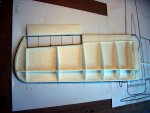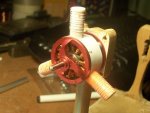quorneng
Master member
The Fokker V25 was a prototype built in the closing stages of WWI and in a configuration that was well ahead of its time.
Only one was built and there are only 2 known published photographs.

A neat low wing monoplane with what was basically a Triplane fuselage mated to a new plywood covered wing.
Although entered for the January 1918 fighter competition and possessed a good performance it was immediately rejected on the grounds of poor downward visibility.
This problem was overcome with the very similar parasol wing Fokker DVIII which won the April competition but as a design it was a bit of a dead end as far as future development was concerned. The RAF in particular retained the braced biplane layout for nearly 20 more years. One can only speculate that if the V25 been accepted the classic low wing monoplane fighter might have been adopted much earlier.
There are no 3 views available but its similarity to the DVIII meant I could 'reverse engineer' a V25 from it.

For practical reason this was going to small, light and made entirely of 2mm Depron.
The all Depron wing.

The top skin added and the aileron cut out just as they did in the original.

The wing section was fairly generous to give the original a reasonably deep spar.

The fuselage is little more than a hollow Depron box with just an engine bulkhead and a single former behind the cockpit. The elevator servo is mounted right up against the bulkhead.

External pull/pull cables connect it to the elevator.
The ailerons are done the same way with a single servo in the wing leading edge.

A closed loop cable runs externally through tiny eyes fixed to the top and bottom of the wing surface.

And connects to the aileron horns.

The battery box is also right up against the bulkhead.

The aileron closed loop cable runs through the drinking straw tube.
It has a scale Oberursel rotary, the crankcase of which is the brushless bell so it will go round with the prop!

Each cylinder is a thin paper tube with a Depron cylinder head. Each weighs 0.1g.
Painted the complete 9 cylinder 'engine' adds just 1.4g to the brushless motor.

A test run of the rotary on a 2s LiPo.
The 'clicking' is interference from the ESC on the camera mic!
This also allows an almost true scale engine mounting on the bulkhead.

Still quite a bit to do.
Only one was built and there are only 2 known published photographs.

A neat low wing monoplane with what was basically a Triplane fuselage mated to a new plywood covered wing.
Although entered for the January 1918 fighter competition and possessed a good performance it was immediately rejected on the grounds of poor downward visibility.
This problem was overcome with the very similar parasol wing Fokker DVIII which won the April competition but as a design it was a bit of a dead end as far as future development was concerned. The RAF in particular retained the braced biplane layout for nearly 20 more years. One can only speculate that if the V25 been accepted the classic low wing monoplane fighter might have been adopted much earlier.
There are no 3 views available but its similarity to the DVIII meant I could 'reverse engineer' a V25 from it.

For practical reason this was going to small, light and made entirely of 2mm Depron.
The all Depron wing.

The top skin added and the aileron cut out just as they did in the original.

The wing section was fairly generous to give the original a reasonably deep spar.

The fuselage is little more than a hollow Depron box with just an engine bulkhead and a single former behind the cockpit. The elevator servo is mounted right up against the bulkhead.

External pull/pull cables connect it to the elevator.
The ailerons are done the same way with a single servo in the wing leading edge.

A closed loop cable runs externally through tiny eyes fixed to the top and bottom of the wing surface.

And connects to the aileron horns.

The battery box is also right up against the bulkhead.

The aileron closed loop cable runs through the drinking straw tube.
It has a scale Oberursel rotary, the crankcase of which is the brushless bell so it will go round with the prop!

Each cylinder is a thin paper tube with a Depron cylinder head. Each weighs 0.1g.
Painted the complete 9 cylinder 'engine' adds just 1.4g to the brushless motor.

A test run of the rotary on a 2s LiPo.
This also allows an almost true scale engine mounting on the bulkhead.

Still quite a bit to do.
Last edited:




















